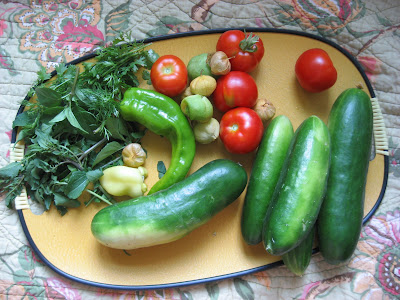
A fresh sunburn sits proudly on my shoulders, neck and chest. Tom and I take long after-dinner walks through the neighborhood, where kids play in the street until their mothers call them in only when the sun gives up its very last ounce of light. Gardens are watered by 6am to give plants the best chance of taking up water. The sometimes faint and sometimes overwhelming scent of burning charcoal wafts through SE Portland. Summer has arrived.
In the garden much has happened over the past month, and I have written very little about it. I’m finding it difficult to make myself sit down and write. I’m in the garden instead. I’ll try my best to jot down notes when I can as I know I’ll thank myself next year when I need to be reminded of what the 2009 season was like. Here is a quick recap of what’s been going on:
1. Tomatoes are producing beautiful green fruit. We now have about 11 plants, mostly because they kept being offered to me and I couldn’t resist.
2. We are now up to 10 pepper plants for the same reason. We’ve got several varieties including many italian types.
3. The red orach is getting very tall. I’m letting several plants go to seed so that I can see the plant’s entire life cycle (it is said to be very beautiful when it flowers) and to save seed.
4. Peas are growing like mad. I planted them too close to the tomatoes, which they now shade. A farmer friend suggested I release them from their trellises and place them on the ground—they are vines after all. I’ve done so, and the tomatoes appear much happier. But I’ve sacrificed my pathways for the peas, so now I must jump over them to access other plants. This has been a great learning experience in the importance of timing and placement.
5. Beets were slow to get going, but we are now enjoying perfectly formed deep red globes. Thanks to the floating row cover provided by my dad, we are also enjoying tender pest-free beet tops.
6. The garlic (both hard and soft neck) is now curing on the back porch under the shade of the ginkgo, with the frequent breezes of the last few days helping to dry them. The garlic got rust this year, which I’ve never experienced. The entire community garden seems to have contracted it. It has affected the leaves but not the bulbs, although I’m wondering if this may mean that they won’t store well. We may have to eat all 22 bulbs sooner rather than later.
7. I’m finding it more and more difficult to garden in the middle of a city park in the middle of summer. Half-naked dodgeball games with blasting music, back-to-back kickball sessions in the diamond adjacent to my plot, and bicycles locked up to the garden gate making it impossible to use the entrance, are all making me a little mad (both angry and crazy). Tom reminds me that this is a public park and that these kids are just having fun, and he is right. And I just want to be a gardener, having some peace. I understand that my expectations are askew for my particular situation. I’m idealistic. But until something else comes along, this is what I have to work with. In this park, I’m learning what is important to my gardening experience. And, I’m learning to go early in the day–dodgeball rarely starts before 2pm.
 Last weekend I harvested Jerusalem artichokes with friends at their community garden. These are generous plants, each stalk producing about five pounds of crunchy tubers. With eight pounds of chokes in my possession, I decided to plant a couple at the farm, store some in the crisper for later use—perhaps in a creamy gratin—, and pickle most in brine in the basement. The chokes have been burping like frogs in their crock now for about five days and are nearly ready to eat.
Last weekend I harvested Jerusalem artichokes with friends at their community garden. These are generous plants, each stalk producing about five pounds of crunchy tubers. With eight pounds of chokes in my possession, I decided to plant a couple at the farm, store some in the crisper for later use—perhaps in a creamy gratin—, and pickle most in brine in the basement. The chokes have been burping like frogs in their crock now for about five days and are nearly ready to eat.




















































